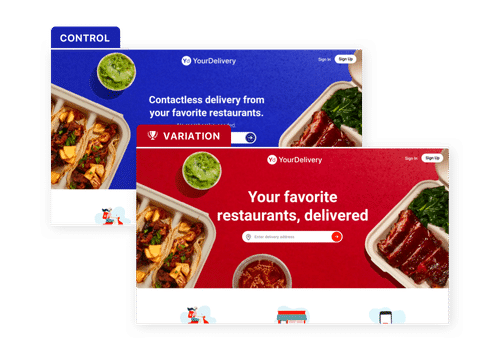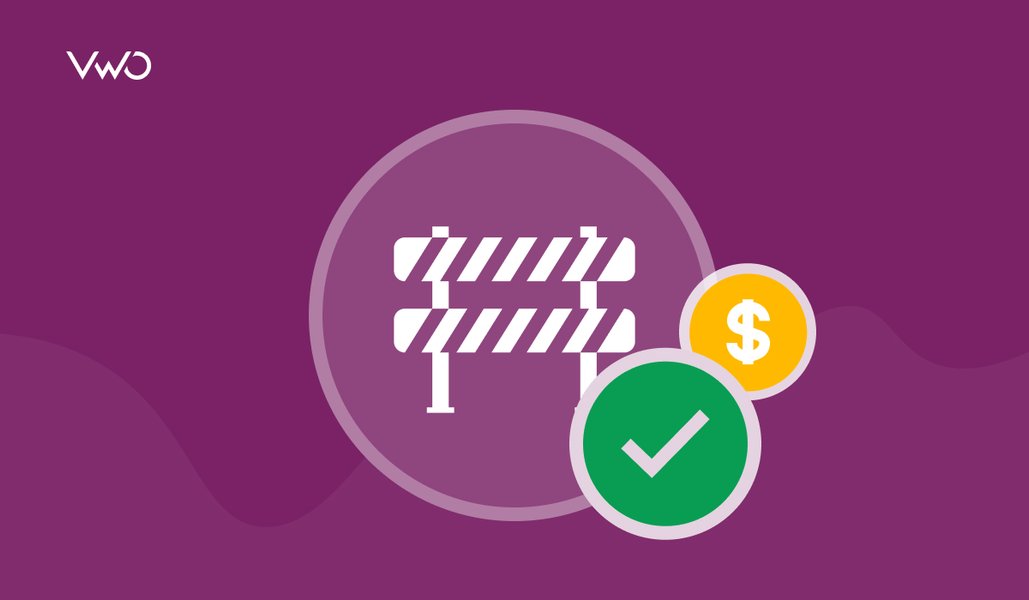Zero to Test: A CRO Kickstart Guide for Low-Adoption Industries
When we talk about the best examples of experimentation, names like Amazon, Netflix, and Booking.com often come up.
They run thousands of tests annually, constantly improving the user experience and boosting conversions.
Now, this can lead to the belief that testing is only suited for fast-moving industries like eCommerce or travel.
But that’s not the full picture.
A/B testing is a reliable method to make data-driven decisions, no matter the industry. Yet, despite its clear benefits, many sectors still struggle with low adoption rates.
In this blog, we’ll explore the reasons behind this gap and the systemic barriers that make testing seem out of reach for certain industries.
Further, we’ll provide a practical roadmap for teams in low-adoption industries operating under constraints to embrace experimentation in a way that aligns with their circumstances.

Why hasn’t testing caught on in some industries?
If A/B testing is such a powerful tool, why haven’t all industries embraced it? Here are some common obstacles:
1. Legacy systems make change risky
Testing requires the flexibility to implement and evaluate different options. But in legacy environments, where changes are slow and high-risk, testing can seem impractical, even when performance issues are well known. Outdated systems not built for quick updates make even small changes challenging, causing testing efforts to feel risky or unnecessary.
Take a government department with a citizen portal for filing tax documents. If the system was built a decade ago, even small updates, like changing the page layout or wording, might need to go through layers of approval, including development teams, security checks, and full regression testing.
Now imagine a digital officer notices users are dropping off midway through the form and suggests testing a simpler layout. It’s a solid idea, but getting sign-off from multiple departments could take weeks. In the meantime, users who get stuck often end up calling support or visiting help centers, adding strain to already stretched teams. As a result, the current version may stay live simply because it’s too complex to change.
Some web and mobile services run on outdated software that cannot pull or push information to modern web services. This becomes a technically difficult roadblock—engineering teams may feel overwhelmed because solving it means overhauling legacy systems.
Olabinjo Aderinan, Lifecycle Marketing Strategist (Source)
With VWO’s Visual Editor, you can test changes through VWO’s SmartCode integration without touching your core infrastructure, reducing deployment risks and bypassing lengthy approval cycles. Our server-side testing capabilities also allow you to test backend logic changes safely with feature flags.
2. Regulatory and compliance concerns
In highly regulated industries, any change to approved language or design can feel like a liability. Teams often stick to the status quo, avoiding tests that might seem misleading or conflict with regulated messaging.
Take this example: A life insurance provider wants to test two homepage headline variants—
- “Coverage in just a few clicks”
- “Apply today, get approved instantly”
While the marketing team is aiming to improve quote requests, the compliance team intervenes.
They argue that “a few clicks” might imply guaranteed coverage without underwriting, and “approved instantly” could be considered misleading under state insurance regulations.
Instead of working together to find legally sound alternatives to test, the entire initiative is dropped. This means losing the opportunity to improve performance or understand what messaging works best within compliant boundaries.
One option here is to use VWO’s advanced user segmentation and targeting. It allows you to test compliant variations with specific audiences while maintaining approved messaging for others.

3. Lack of CRO culture or in-house expertise
In many organizations, digital teams are small and primarily focused on website upkeep or basic lead generation. Testing rarely becomes a priority when the right mindset, structure, or resources aren’t yet in place.
For example, a supplier of construction materials has a basic website with “Request a Quote” forms on each product page. Their team notices visitors often abandon the form midway, but they lack a CRO specialist or experimentation lead to explore and validate potential solutions.
No tools are in place, there’s unclear ownership, and the team isn’t sure how to begin. So, even with friction present, no changes take place. As a result, decisions are made based on assumptions instead of validated findings.
4. Misconception: “Testing is for B2C”
Many B2B and service-based organizations assume that testing only applies to businesses selling products directly to consumers. They often underestimate how testing can enhance lead generation, engagement, or other important outcomes.
For instance, a law firm serving businesses has a “Contact Us” form at the bottom of their service pages. They get decent traffic but assume that testing different CTAs or form copy won’t have much impact because, in their words, “this isn’t eCommerce.” What they miss is that small improvements in form completions could translate into significantly more consultations booked.
VWO’s Form Analytics and feature flag capabilities are perfect for B2B product optimization, enabling teams to test different user onboarding flows, feature discovery paths, and engagement touchpoints across their product ecosystem. This makes experimentation just as critical for B2B organizations as it is for consumer-facing brands.

5. Siloed teams block progress
In larger or traditionally structured organizations, teams like marketing, product, IT, legal, and analytics often work separately. Each team has its own goals, timelines, and approval processes. This lack of coordination slows down initiatives that require input from multiple teams, such as A/B testing.
Consider a telecom company that wants to test different ways of displaying mobile plan options to improve engagement. The marketing team creates the test variations, but that’s where the silos kick in.
IT owns the website. Analytics owns the tracking. Legal owns the language. Each team operates on its own timeline, with its own priorities. And no one owns the test from start to finish.
When ownership is unclear and departments don’t work smoothly together, testing momentum fades. In siloed setups, everyone assumes someone else will take care of it—but no one does.
VWO’s unified platform eliminates silo friction with role-based permissions, integrated analytics, and collaborative workflows, ensuring that every stakeholder can contribute without bottlenecks, and testing doesn’t get lost in cross-team confusion.
Marketing integration does not need to begin with complex workflows. It starts with clear goals, open communication, and a willingness to connect the dots across teams. Many organizations are still built around channel‑specific silos. Even if the information seems irrelevant at first, it might provide a crucial piece of the puzzle for another team.
Jin Ma, Director of Experience, Media, dentsu, Singapore (Source)
Industries where testing can improve outcomes
So, how did we arrive at the conclusion that some industries are still slow to adopt testing?
We analyzed over 100,000 experiments run across 16 industries on our VWO platform, and observed that testing activity was relatively low in a few sectors. Let’s take a look at which industries these are.
B2B manufacturing
B2B manufacturing firms often fall behind in digital optimization practices, including A/B testing. Many of these businesses prioritize offline sales, distribution networks, and traditional product catalogs. Their websites typically serve as digital brochures rather than interactive lead-generation tools.
In addition, many B2B manufacturers rely on legacy ERP or CMS platforms, which make testing technically complex. Publicly documented examples of B2B manufacturers running experiments on lead forms, product pages, or comparison tools are rare. This suggests that optimization is not yet a priority.
What they can test:
– Product comparison tables to help technical buyers make faster decisions
– Placement and wording of “Request a Quote” or “Contact Sales” CTAs
– Testing gated vs. ungated access to product spec sheets or PDFs
– Lead form field order or optional vs. mandatory fields
See how EcoFoil boosted purchases by 86% by testing a simple yet strategic change—relocating the help box above the fold on its homepage. The goal was to improve visibility and support customers at the right moment in their decision-making journey.
Consulting
Consulting firms may avoid testing public-facing content due to the high-stakes, trust-driven nature of their services. Messaging is typically crafted to uphold credibility and maintain a professional tone. Since client relationships are built on authority and discretion, even small tweaks to language can feel risky, especially if they might come across as promotional or misaligned with the firm’s values.
For instance, a legal consulting firm considers testing two homepage headlines: “Trusted Advisors in Corporate Law” versus “Win Your Case with Expert Legal Support.” While the second option may sound more compelling from a marketing perspective, it raises concerns internally. The phrase “win your case” could imply guaranteed outcomes, exposing the firm to reputational or compliance risk. As a result, the idea is shelved because the perceived downside outweighs the potential benefit.
What they can test:
– Consultation CTAs: “Book a Call” vs. “Get Expert Advice” vs. “Schedule a 15-Min Consultation”
– Page layout: FAQs above or below service descriptions
– Lead form field count: shorter vs. longer intake forms
– Exit popups offering to call back or send guides
Maintain testing momentum without letting a design‑bandwidth crunch derail your timeline—VWO Copilot can generate polished, on‑brand variations from a simple prompt. Moreover, it analyzes heatmaps and recordings for you, surfacing the clicks, scrolls, and rage points, uncovering the friction users face so you can plan tests around them and improve their experience.
Government and nonprofit
Government agencies and nonprofit organizations often face challenges with testing due to limited resources, complicated approval processes, and a risk-averse mindset. Websites in this space are often managed by external vendors or outdated CMS platforms, making agile experimentation difficult.
Further, decision-makers may be hesitant to approve tests out of concern for public perception or compliance. While testing can greatly enhance donation flows, many nonprofits lack the internal capacity or tools to carry it out. With budget limits and strict communication protocols, testing gets pushed aside in favor of stable messaging—despite the potential benefits.
That’s why VWO is especially well-suited for public sector and nonprofit use. Its enterprise-grade security features and robust compliance certifications help remove barriers to experimentation, giving teams the confidence to test, learn, and optimize without compromising on trust or safety.
What they can test:
– Donation messaging: “Help 10 families this winter” vs. “Support our winter appeal”
– Button language: “Donate Now” vs. “Make an Impact”
– Layout of donation amounts: pre-filled options vs. open field
– Donation amount presets: $25 / $50 / $100 vs. blank input field, to test impact on average donation value and completion rate
See how No Baby Blisters simplified their donation page and boosted contributions by 47.46% using VWO. By removing menus and trust badges, they kept donors focused on the most important action: contributing to the cause. Click the image below to watch.
Insurance and financial companies
Financial services and insurance aren’t low-adoption industries by volume, but experimentation here is often constrained. It’s more reactive than proactive and rarely embedded across user journeys. These companies operate in highly regulated environments, creating a culture of caution around experimentation.
Messaging changes, even minor ones, may require legal review, slowing down the pace of testing or discouraging it altogether. In addition, many of these organizations rely on legacy systems or fragmented digital stacks, which make it difficult to run tests across customer journeys.
What they can test:
- Quote form CTAs: “Get Your Free Quote” vs. “See Your Rates”
- Trust signals: Showing financial safety badges or ratings near forms
- Headline framing: “Protect Your Future” vs. “Affordable Plans, Backed by Experts”
- Lead form layout: Multi-step form vs. single long form
See how HDFC ERGO reduced customer acquisition costs by 47% using VWO. By optimizing landing page content, streamlining messaging, and testing high-impact CTAs, they significantly improved conversions, proving the ROI of structured experimentation.
Real estate
The real estate industry—especially in residential and commercial listings—hasn’t widely embraced testing. While large portals like Zillow or Redfin may experiment, case studies from local agencies and property sites are rare. Most websites rely on templated listings, with key interactions like contacting agents or booking visits happening offline.
This fragmentation, along with switching between aggregator sites and agency pages, makes experimentation harder to justify or track. As a result, testing opportunities like optimizing CTAs, guided search flows, or inquiry forms are often missed.
What they can test:
– CTA visibility: Fixed “Contact Agent” buttons vs. buttons at the bottom of listings
– “Schedule Visit” prompt wording and placement
– Visual layout of listings—map-first vs. list-first
– Trust-building elements (agent ratings, testimonials, verified listing badges)
See how Morningstar Properties increased clicks on their inquiry button by 44.11% on their mobile website—by simply testing a copy change in the CTA. The CTA, placed above the main navigation bar, led to their inquiry form. By refining the message, they aimed to drive more clicks—and ultimately more submissions. The result proved the power of clear, action-oriented language.
How low-adoption industries can start testing (despite constraints)
Here’s the good news: You don’t need a large CRO team, advanced analytics infrastructure, or a huge optimization budget to begin. What you really need is a focused, low-friction approach that fits your current structure—one that builds credibility over time.
1. Start small
You don’t need to revamp your entire website to show the value of testing. Start with just one change on a key page—a headline, a CTA, or a form layout. This lowers resistance and reduces perceived risk.
Begin where friction is clear and outcomes can be measured. One improved conversion point can inspire broader confidence within your team.
Small wins can be powerful. When leadership sees even a slight improvement, like a 12% increase in callback requests or fewer form abandons, they start to realize that testing is a smarter way to enact changes.
2. Work around legacy systems
Legacy CMS, ERP, or booking systems are a major reason testing stalls in traditional industries. These platforms often lack flexibility, and teams fear breaking something just by making changes.
Instead of waiting for a full tech overhaul, use overlay-based testing tools like VWO that sit on top of your existing infrastructure. This allows you to test headlines, CTAs, layouts, and messaging without touching your backend systems.
You can also start by testing standalone landing pages or campaign-specific flows that aren’t tied directly to your core site. This lowers the barrier to entry, avoids platform limitations, and helps you prove value before advocating for deeper integration.
3. Focus on learning, not just uplifts
In the initial testing stages, your goal should not solely be about performance improvement—aim for insights too. VWO’s comprehensive analytics dashboard provides valuable user behavior insights even from tests that show no statistical difference. Such tests still offer meaningful information about how people engage with your content, navigate your site, and make choices. Positioning testing as a way to decrease guesswork and improve decision-making (rather than solely pursuing big wins) sets realistic expectations and opens up more possibilities internally.
4. Set clear, contextual goals
Vanity goals like “improve user engagement” don’t offer enough direction or measurable value. Instead, tie your experiments to specific business outcomes that directly impact growth or operations.
Examples:
- B2B: Increase qualified lead submissions by 10% from the pricing page
- Nonprofit: Boost recurring mobile donations by 20%
- Legal services: Raise call-back requests from visitors in serviceable areas
The more specific your goals, the easier it is to track performance, measure success, and justify future testing efforts.
5. Make a case for stakeholder buy-in
To get others on board, you need to position testing as a safe and strategic enabler, not a radical change. Leaders are more likely to support testing when they see:
- It doesn’t interrupt operations
- It leads to evidence-based decisions
- It helps prioritize dev/design work more effectively
- It mitigates risk by validating ideas before full rollout
You can also show industry examples or benchmarks (even from outside your sector) to demonstrate how experimentation has helped similar businesses make smarter, faster decisions.
Once you land a small win, share it. Create a quick slide, email, or dashboard snapshot. When stakeholders see real numbers improving, they’re more likely to approve the next test.
6. Assign test ownership
While buy-in creates strategic alignment, ownership ensures execution clarity. One of the biggest reasons testing fails to launch is that it’s everyone’s job and no one’s responsibility. Assigning a clear test owner, whether it’s someone in marketing, UX, or analytics, ensures the process has momentum and accountability.
VWO’s user management system allows you to assign clear test ownership with appropriate permissions, so responsibilities are defined from the start and handoffs are minimized. Even if you start with one owner managing one test a month, that consistency builds confidence and builds toward a repeatable workflow.
7. Scale with structure
Once you’ve built momentum with consistent testing, the next step is to scale with structure. This means standardizing how test ideas are collected, prioritized, and documented. Use a simple backlog or planning tool (like VWO Plan) to track experiments and share learnings across teams.
As confidence grows, you can start making the case for more advanced testing, like server-side experiments or personalization. When stakeholders see early results, they’re more likely to support an ambitious experimentation program with the resources and access it requires.

Putting it together
Testing isn’t just for tech giants or digital-first disruptors. It’s for any organization that wants to reduce friction, make better decisions, and serve its users more effectively.
Yes, legacy systems, compliance concerns, and cultural barriers exist, but they don’t have to be deal-breakers. With small, intentional steps, even the most resource-constrained teams can build momentum and start seeing the benefits of testing.
You don’t need thousands of tests to start. You just need one that proves change is possible.
Book a personalized demo with our optimization experts to see how VWO can work within your industry’s constraints. We’ll show you specific features designed for your challenges and help you build a testing roadmap that fits your resources.























